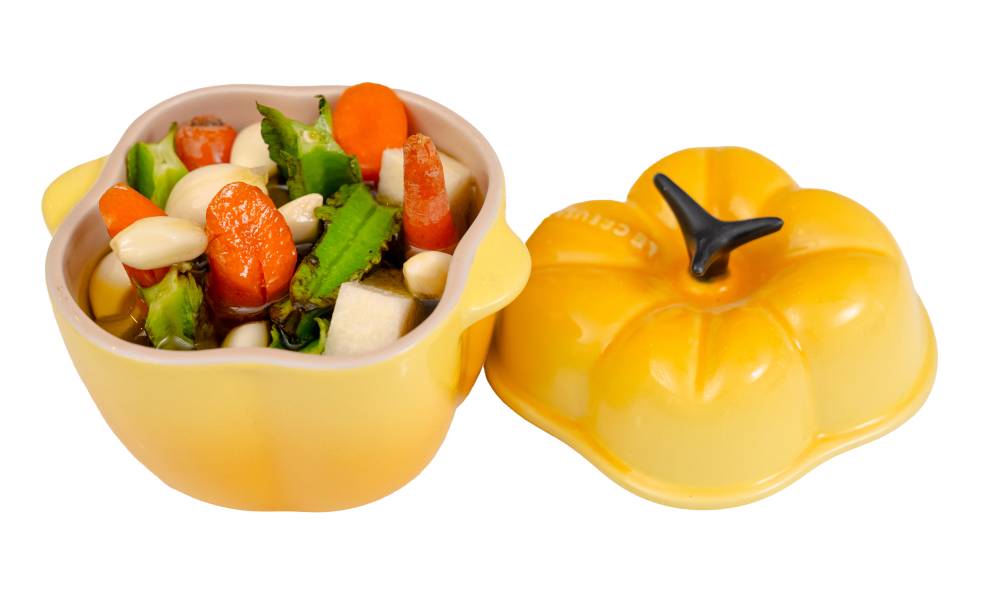Confit in a covered court

Long before modern preservation methods like freezing and vacuum sealing, salt, fat, and air-drying were the methods to prolong the shelf life of food. Food preservation was a necessity to prepare for lean seasons, enhance food flavor, and extend the shelf life of food.
But in today’s modern world, the idea of preserving food is a dying art. While many worry about the scarcity of food, people fail to realize that there are tons of produce thrown out every day due to being overripe or not considered store-worthy. In our own homes, food in the refrigerator can quickly go bad if forgotten.
An ingenious way to preserve food
Confit, a word derived from the French verb “confire,” meaning “to preserve,” is both a culinary technique and a testament to human ingenuity in food preservation—long before refrigeration.
While often associated with the elegant traditions of French cuisine, the origins and evolution of confit reveal a deeper, more practical history rooted in survival and resourcefulness. In ancient times, preserving meat by slowly cooking it in its own fat and then storing it submerged in that fat was a method used across cultures. The fat formed a protective seal, preventing air and bacteria from spoiling the meat.
Confit was not only a necessity but also a tradition, passed down through generations of rural households who needed to make the most of their seasonal harvests and livestock. By the Middle Ages, the confit method had become refined in France. Duck and goose were commonly used, particularly in regions with a strong foie gras culture.
First, the birds were salted to draw out moisture, then slowly poached in their own rendered fat over low heat. Once cooked, the meat was stored in earthenware crocks and covered completely with fat, allowing it to last for weeks or even months without spoiling.
Of modern and inventive ways
Over time, the technique was extended to other ingredients as well. Tomatoes, garlic, onions, and even fruits were “confited” in oil or sugar, depending on the desired result. These variations demonstrated the versatility of the confit method beyond just meat.
Modern chefs have also embraced and reinterpreted the technique, confiting everything from pork belly to fish, and even vegetables. Olive oil has even become a common substitute for animal fat in lighter dishes. The slow, gentle poaching method aligns well with contemporary trends that emphasize natural flavors, minimal processing, and artisanal techniques.
In many households around the rural areas of the Philippines, refrigerators are not a common household appliance. The idea of food preservation, as our ancestors once did, is also a long-forgotten practice. While working on the Walang Gutom project in Ormoc City, I thought about making a confit dish in a covered court and how I would pull it off. The idea was to extend the shelf life of the meat that the beneficiaries were given, so that they would not be forced to eat everything in one day.

I then decided to confit a chicken—using whatever herbs were available in the palengke. We found garlic, bay leaves, salt, and pepper to be the easiest to use. Since olive oil was not included in the package, I used coconut oil.
Slowly but surely, I created a chicken confit using a butane burner, chicken, salt, pepper, garlic, and bay leaves in about an hour and a half. Though far from a fine dining idea of a chicken confit, this particular dish serves a purpose: to have the chicken available as a condiment and to encourage people to eat more vegetables. I told the audience to think of the chicken as a special topping rather than the main event—something they can add to pancit, lumpia, or fried rice.
I also mentioned that, unlike the oil that is thrown out when deep frying, the chicken confit oil can be used to flavor other dishes, and will even be rendered with a chicken flavor.
From necessity to luxury to simplicity
Cooking chicken, or any meat, confit-style, differs from deep frying. Deep-fried food absorbs fat from the oil more easily, especially when battered, as it is cooked at high heat for a short period of time. Cooking at a lower temperature for a longer time prevents the oil from being absorbed.
This is why, when making a vegetable confit, it is more about infusing the vegetables with flavor and preserving them—rather than cooking them through.
I created a vegetable confit out of commonly found Filipino vegetables to try out different ways of enjoying them. Poaching the vegetables in olive oil with garlic and other spices adds a new flavor profile to the vegetables and your dish as a whole. Think of the vegetable confit as a condiment to add to pastas and dips, or as something easy to throw on a fish or chicken dish when time is short.
The history of confit is a story of transformation—from necessity to luxury, from farmhouse kitchens to Michelin-starred restaurants, and even to covered courts. Rooted in the need to preserve food, it has endured as a cherished culinary technique because of the exquisite result it produces.
Whether in a rustic cassoulet or made with Filipino vegetables, this technique is cost-effective and easy to do, with fruitful results to show for.

Vegetable Confit
Ingredients:
1 tsp salt
2 cups olive oil
6 pcs sigarilyas
6 pcs garlic cloves
2 pcs carrots, chopped
1 singkamas, cut into halves
2 cups olive oil
Procedure:
1. Lay out the vegetables in an oven-proof pot or pan. Sprinkle salt on them.
2. Add the olive oil and herbs. Cook in the oven at 140 degrees Celsius for 1 hour, ensuring that the vegetables do not burn. You may need less time if your oven is on the hot side.
3. Place confit vegetables in a jar and store in the refrigerator for up to one month. The garlic may turn green.

















